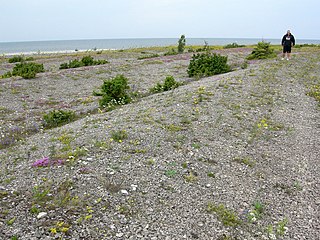
The Burkholderiales are an order of Betaproteobacteria in the phylum Pseudomonadota. Like all Pseudomonadota, they are Gram-negative. They include several pathogenic bacteria, including species of Burkholderia, Bordetella, and Ralstonia. They also include Oxalobacter and related genera, which are unusual in using oxalic acid as their source of carbon. Other well-studied genera include Alcaligenes, Cupriavidus, Achromobacter, Comamonas, Delftia, Massilia, Duganella, Janthinobacterium, Polynucleobacter, non-pathogenic Paraburkholderia, Caballeronia, Polaromonas, Thiomonas, Collimonas, Hydrogenophaga, Sphaerotilus, Variovorax, Acidovorax, Rubrivivax and Rhodoferax, and Herbaspirillum.

A beach ridge is a wave-swept or wave-deposited ridge running parallel to a shoreline. It is commonly composed of sand as well as sediment worked from underlying beach material. The movement of sediment by wave action is called littoral transport. Movement of material parallel to the shoreline is called longshore transport. Movement perpendicular to the shore is called on-offshore transport. A beach ridge may be capped by, or associated with, sand dunes. The height of a beach ridge is affected by wave size and energy.
Hydrogenophaga is a genus of comamonad bacteria, several of which were formerly classified in the genus Pseudomonas.
Hydrogenophaga flava is a species of Gram-negative, rod-shaped comamonad bacteria.
Arsenate reductase (cytochrome c) (EC 1.20.2.1, arsenite oxidase) is an enzyme with systematic name arsenite:cytochrome c oxidoreductase. This enzyme catalyses the following chemical reaction
The enzyme 4-sulfomuconolactone hydrolase (EC 3.1.1.92; systematic name 4-sulfomuconolactone sulfohydrolase This enzyme catalyses the following chemical reaction
Hydrogenophaga atypica is a Gram-negative, oxidase-positive, rod-shaped, motile bacterium from the Comamonadaceae family, which was isolated from wastewater from an activated sludge. The colonies of H. atypica are pale yellow.
Hydrogenophaga bisanensis is a Gram-negative, non-spore-forming, rod-shaped bacterium from the Comamonadaceae family, which was isolated from wastewater from a textile dye works in Korea. Colonies of H. bisanensis are moderate yellow in color.
Hydrogenophaga caeni is a Gram-negative, anaerobic, catalase- and oxidase-positive, motile bacterium from the Comamonadaceae family, with a single polar flagellum, which was isolated from an activated sludge. Colonies of H. caeni are white colored.
Hydrogenophaga defluvii is a Gram-negative, oxidase-positive, rod-shaped, motile bacterium from the Comamonadaceae family, which was isolated from wastewater. Colonies of H. defluvii are pale yellow in color.
Hydrogenophaga intermedia is a Gram-negative, oxidase-positive bacterium from the Comamonadaceae family. It has the ability to degrade 4-aminobenzenesulfonate.
Hydrogenophaga palleronii is a bacterium from the Comamonadaceae family, which has the ability to degrade 4-aminobenzenesulfonate.
Hydrogenophaga pseudoflava is a bacterium from the Comamonadaceae family.
Hydrogenophaga taeniospiralis is a catalase-negative bacterium from the Comamonadaceae family.
Xenophilus azovorans is a bacterium from the genus Xenophilus which has been isolated from soil in Switzerland.
Hydrogenophaga luteola is a bacterium from the genus of Hydrogenophaga which has been isolated from pond water from Shangqiu in China.
Hydrogenophaga aquatica is a Gram-negative, rod-shaped and aerobic bacterium from the genus of Hydrogenophaga which has been isolated from a hot spring.
Hydrogenophaga crassostreae is a Gram-negative, rod-shaped, aerobic and motile bacterium from the genus of Hydrogenophaga which has been isolated from the oyster Crassostrea gigas.
Hydrogenophaga soli is a Gram-negative, rod-shaped, strictly aerobic and motile bacterium from the genus of Hydrogenophaga which has been isolated from soil from a rice field from Goyang in Korea.
Hydrogenophaga is a genus of bacteria from the family of Comamonadaceae with one known species. Hylemonella gracilis has been isolated from pondwater.

